
Metamorphisms are not all alike. A variety of metamorphisms occur depending on temperature and pressure (T/P) conditions. The variety of metamorphic processes can be summarized in a T/P phase diagram (below).
Observe that temperature increases across the top from " normal" earth surface conditions to nearly 1000 degrees C.
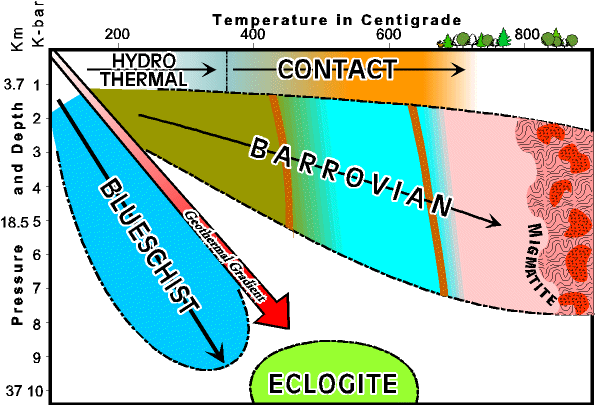
Pressure is plotted down the side of the diagram. The earth's surface is at the top of the diagram, so the further down you go the greater the pressure. Pressure is measured in bars. A bar is one atmosphere of pressure, about 14 pounds per square inch. The scale on the phase diagram is in kilobars, thousands of atmosphere of pressure. We have also plotted depths in kilometers along with the pressure.
[Note that this is drawn the opposite of a technical phase diagram where pressure increases from the bottom to the top of the diagram. We have chosen this diagram to allow easy reference to pressure and depth, which naturally increases as one descends deeper.]
Note also the diagonal red arrow, the geothermal gradient, the average increase in temperature with depth.
Observe on the phase diagram above the five kinds of metamorphism: Hydrothermal, Contact, Barrovian (sometimes called " regional" ), Blueschist, and Eclogite. Each is introduced below.
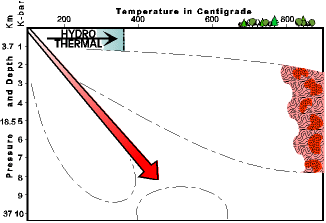 Hydrothermal Metamorphism:
Hydrothermal Metamorphism:>>>Low Temp./Low Pressure
>>>Typical Rocks: pegamatites, serpentinite, soapstone
Hydrothermal metamorphism occurs when hot, chemically active, mineral laden waters interact with a surrounding preexisting rock (called the country rock). Most hydrothermal metamorphism takes place at low pressures and relatively low temperature, as the phase diagram shows. It is one of the most pervasive and widespread types of metamorphism, although most of it cannot be seen easily. There are also several distinctly differnt types of hydrothermal metamorphism.
IGNEOUS FLUIDS AND PEGMATITES: The most spectacular hydrothermal metamorphism takes place as an after effect of igneous activity. Magmas have lots of water with dissolved minerals, but as the magma crystallizes the mineral laden water is driven off into the surrounding country rock where it seeps into cracks and pores precipitating the minerals.
The most spectacular result of this is a pegmatite, a very coarse grained felsic igneous rock. Pegmatites commonly have single crystals measured in feet in size, as well as a host of exotic minerals, including some of the most important gem minerals.
Hydrothermal deposits of this type also produce many important mineral deposits, from silver and gold to copper.
OCEANIC HYDROTHERMAL METAMORPHISM: A second type of hydrothermal metamorphism takes place at oceanic rift centers (divergent plate boundaries). Here magma ozzes out onto the ocean floor to form pillow basalts. While the rock is still hot sea water carrying all its salts percolates into the rocks where a lot of chemical reactions take place. Minerals are leached out of the rock and carried to the surface where they often form smokers, gysers on the ocean floor (see Vents Program, or ocean chimneys, or vents video clips).
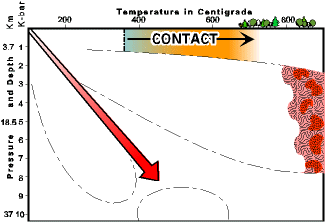 Contact Metamorphism:
Contact Metamorphism:>>>High Temp./Low Pressure
>>>Typical Rocks: hornfels, quartzite, marble, skarn
Contact metamorphism occurs in the " country rock" (the rock intruded by and surrounding an igneous intrusion). Rocks are " baked" into a ceramic from heat escaping from intrusives, often enhanced by hydrothermal fluids. The intensity of metamorphism decreases with distance from the intrusion, until at some distance away the rock is unaltered country rock.
The metamorphism often occurs in aureoles, or zones surrounding the intrusion. Close to the intrusion is the hydrothermal (or metasomatic) aureole where minerals from the hot fluids have their greatest effect. Further away is the thermal aureole where heat is the primary effect. The dimensions of the aureoles are dependent on the size of the intrusive body and the amount of water present. In the absence of fluids, the aureole is very small.
The assemblage of new minerals that grow in the country rock depend on the composition of the country rock. For a complex sedimentary parent of sandstones and shales, anhydrous (without water) minerals such as garnet and pyroxene occur closest to the intrusion, then hydrous (water rich) minerals such as amphibole and epidote, and at the lowest intensity, chlorite and serpentinite occur.
When an magma intrudes into carbonates such as limestone and dolostone the carbonate reacts with silica from the hydrothermal fluids to form SKARN. Many special lime-bearing silicate minerals form here.
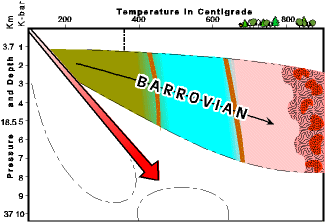 Barrovian Metamorphism:
Barrovian Metamorphism:Low-High Temp./Intermediate Pressure
Typical Rocks: slate, phyllite, schist, gneiss, migmatite; quartzite, marble
This is a common, widespread, large scale metamorphism typically ssociated with major orogenic (mountain building) events. Sometimes this is referred to as " regional metamorphism" but since it is not the only metamorphism to take place on a regional scale Barrovian is a more precise name.
Barrovian metamorphism produces some of the most common metamorphic rocks, many of which are spectacularly beautiful and thus used as building stones. There is much to explore to understand these rocks and so we will deal with them at another page.
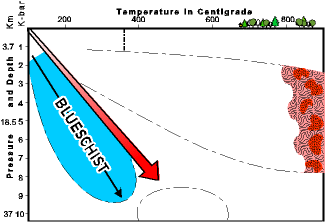 Blueschist Metamorphism:
Blueschist Metamorphism:Low Temp./High Pressure
Typical Rocks: blueschist
Blueschist metamorphism occurs at convergent plate boundaries in subduction zones, either under volcanic arcs, or under continents (cordilleran type). Here cold oceanic crust and sediment is rapidly subducted. Pressure increases quickly because of depth, but the temperature lags behind because the rock is being buried faster than it can heat up. Rocks in outcrop appear blue from amphibole mineral glaucophane.
 Eclogite Metamorphism:
Eclogite Metamorphism:Moderate Temp./Very High Pressure
Typical Rocks: eclogite
Eclogite metamorphism takes place in the mantle. The parent rock is ultramafic mantle material, such as peridotite. Eclogite is characterized by a pale green sodic pyroxene (omphacite) and a red garnet (almandine-pyrope), making it a striking rock. Associated minerals are rutile, kyanite, and quartz, and it is not unusual to have retrograde amphibole in the rock too. Since eclogite forms so deep, outcrops are not common.
Go on to: